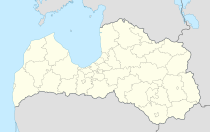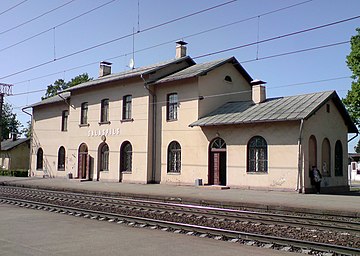Salaspils
| Salaspils ( German : Kirchholm) | ||
|---|---|---|
 |
|
|
| Basic data | ||
| State : |
|
|
| Landscape: | Livonia ( Latvian : Vidzeme ) | |
| Administrative district : | Salaspils novads | |
| Coordinates : | 56 ° 52 ' N , 24 ° 21' E | |
| Residents : | 17,621 (Jan. 1, 2016) | |
| Area : | 12 km² | |
| Population density : | 1,468 inhabitants per km² | |
| Height : | 20 m | |
| City law: | Since 1993 | |
| Website: | www.salaspils.lv | |
| Post Code: | LV-2121, LV-2169 | |
| ISO code: | ||
| Salaspils train station | ||
Salaspils (German: Kirchholm ) is a city in Latvia 18 kilometers southeast of Riga . The city has had its current name since 1917 after the former fortress (lett. Pils ) on an island ( lett. Sala ). In 2016 it had 17,621 inhabitants.
history
Today's place is next to the historic Kirchholm. Excavations between 1964 and 1975 uncovered finds in the area dating back over 11,000 years ago, after which reindeer hunters had set up camp here . Vikings who sailed the Daugava gave the island the name Holme . In the 10th century, tribes settled living in wooden houses Liven on.
In 1186 a fortress was built on the island by the later first Riga bishop Meinhard . From here the Christianization and submission of the surrounding Livian tribes began. After a church was built, the island was called Kirchholm. In 1206 the rebellion of the Ako insurgent was suppressed in a battle near Kirchholm. In 1298 the property came to the Livonian Order . In 1380 a new castle of this order is mentioned on the bank of the Düna. In 1452 a contract was signed between the order and the Riga archbishop Silvester Stodewescher .
With the division of the religious state in 1561, Kirchholm came to the Duchy of Livonia under Polish-Lithuanian rule. In 1577 the fortifications were blown up so that the troops of the approaching Tsar Ivan IV (the Terrible) could not build a base. These fortifications have not been built since then.
In 1603 King Sigismund II. August gave the Rigensians the Martinsinsel as Kirchholm was now called. In 1605 the Battle of Kirchholm took place in the course of the Polish-Swedish War near Salaspils , in which the Polish-Lithuanian armed forces defeated the outnumbered Swedes. 25 years later, Riga became Swedish and secured to the east by extensive fortifications, including in the Salaspils area.
A community school was established under Russian rule in 1753. In 1771 the area was inundated by the Daugava river. In 1861 the Riga - Dünaburg railway line was opened. In 1898 a botanical garden was opened near the train station.
During the First World War , Salaspils was in the front line for two years, which led to severe destruction. After that Salaspils was just a rural area.
In 1974 the historic Kirchholm (= Martinsala) sank in the Daugava because the big dam of the Riga hydroelectric power station was built. As a suburb of Riga, the place grew and in 1979 already had 14,000 inhabitants. In 1993 Salaspils received town charter. Today there are various institutes of the Latvian Academy of Sciences as well as university facilities in Salaspils . An atomic research reactor was operated here from 1961 to 1998 , the dismantling of which is still ongoing.
Salaspils camp
During the Second World War , Salaspils was a police prison and labor re- education camp .
SS-Sturmbannführer Rudolf Lange , initially assigned to Einsatzgruppe A and from December 1941 commander of the Security Police and the SD , planned in October 1941 to set up a police detention center and camp for Jews in Salaspils. The place was easily accessible by the railway connection Riga - Daugavpils; the prisoners were to be used in peat extraction. All “Jews remaining in Riga and Latvia” should be concentrated here, with men and women being separated in order to “prevent further increase”. Latvian “breach of employment contracts” and “work loafers” should also be “reeducated” in the camp.
The first transports of German Jews, who had been diverted to Riga in October 1941, could not yet be taken up in Salaspils and were temporarily housed in the Jungfernhof concentration camp . The camp was expanded by Soviet prisoners of war and deported Czech and some German Jews from the Jungfernhof concentration camp by the spring of 1942. The plans changed several times. Instead of the Jews, "protective prisoners" and deportees from "gang areas" were housed.
A memorial was set up in 1967 to commemorate those who perished in the camp; an exhibition room, several sculptures and a marble block in which a metronome reminds of the heartbeat of the dead and carved lines count the days of suffering.
Town twinning
- Finspång in Sweden , since 1997
- Finsterwalde in Germany , since 2002
- Dzierzgoń in Poland , since 2002
Salaspils novads
The city occupies a territory of 12 km², the area of the rural municipality is 115 km². The Riga hydropower plant's reservoir takes up 15.8% of the entire territory, 30% is formed by forest and 32.5% by agricultural land. Since 2004, the city and rural community have formed the Salaspils district (Salaspils novads) with 23,219 inhabitants (July 1, 2010).
Individual evidence
- ↑ «Latvijas iedzīvotāju skaits pašvaldībās pagastu dalījumā"
- ^ Ordensburg Neu-Kirchholm
- ↑ Information on the website of the city administration (accessed on February 23, 2019)
- ^ Andrej Angrick, Peter Klein: Riga 1941–1944. In: Gerd R. Ueberschär: Places of horror. Crimes in World War II. Darmstadt 2003, ISBN 3-89678-232-0 , p. 197.
literature
- Andrej Angrick , Peter Klein: Riga 1941–1944. In: Gerd R. Ueberschär : Places of horror. Crimes in World War II. Darmstadt 2003, ISBN 3-89678-232-0 , p. 197.
- Andrej Angrick, Peter Klein: The “Final Solution” in Riga. Exploitation and extermination 1941–1944. Darmstadt 2006, ISBN 3-534-19149-8 .
- Латвия под игом нацизма. (German: Latvia under the yoke of the Nazi regime. English: Latvia Under the Nazi Yoke. ) Verlag Europa, Moscow 2006. (Collection of historical documents).
- Hans Feldmann , Heinz von zur Mühlen (Hrsg.): Baltic historical local dictionary, part 2: Latvia (southern Livland and Courland). Böhlau, Cologne 1990, ISBN 3-412-06889-6 , pp. 284-285.
- Astrīda Iltnere (ed.): Latvijas Pagasti, Enciklopēdija. Preses Nams, Riga 2002, ISBN 9984-00-436-8 .



